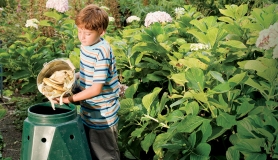Breakfast really is the most important meal of the day. Research tells us that children who eat breakfast have longer attention spans and do better at school, whereas those who don’t are more likely to be easily distracted and fatigued. Choosing a nutritious breakfast – such as any of the recipes I have created here – is best, as the slow release of energy will give your child a more steady flow of fuel, making it easier for him to learn new things. Aside from the research, breakfast is a great time to start the day on the right foot and perhaps to spend time with the parent who may not be around so much in the evenings. When I was a kid, my dad was always my breakfast companion because he sometimes worked late. He used to share a little life lesson with me each morning over my boiled egg and I still fondly remember his words of wisdom
wholemeal almond berry pikelets
This is a favourite breakfast in my house. This recipe is healthier than traditional pikelets because it uses wholemeal flour and includes nutrient-rich berries and ground almonds, without any added sugar. For a delicious variation, replace the mixed berries with one mashed banana. For an extra nutrient boost, stir one tablespoon of chia seeds through the mixture.
MAKES ABOUT 15 • 150g wholemeal self-raising flour • ¼ teaspoon baking powder • 25g ground almonds • 2 eggs • 170 ml milk • 40g butter, melted (or use a nut oil, see note) • 100g fresh or frozen mixed raspberries and blueberries • maple syrup
(optional), to serve • fresh fruit, to serve
TIP I love using walnut or hazelnut oil in my pikelets instead of butter – both add a beautiful flavour. If you have either to hand, replace the butter with 2 tablespoons of oil. Store nut oils in the refrigerator to maximize their shelf life and preserve nutrients.
1. Combine the flour, baking powder and ground almonds in a large bowl. Make a well in the centre and add the egg, milk and melted butter.
2. Start stirring the wet ingredients, gradually drawing in the dry ingredients until just combined – do not overmix. Gently stir through the berries.
3. Heat a non-stick frying pan over medium heat. Working in batches, drop spoonfuls of batter into the pan and cook for 2–3 minutes on each side, or until golden and cooked through.
4. Transfer to a plate and keep warm while cooking the remainder. 5. Serve the warm pikelets topped with maple syrup (if using) and fresh fruit of your liking.
BABY’S SERVE For a younger baby, wait until your baby is managing some finger foods (which may not happen until 8–9 months or older) before offering him these pikelets. Omit the maple syrup and cut into strips that he can easily hold. For an older baby, serve as for a younger baby. TODDLER’S SERVE Serve as is with just a little or no maple syrup.
strawberry coconut porridge
I love my morning porridge, but it can sometimes get a little monotonous. To keep things interesting I use coconut milk from time to time – it adds a delicious creaminess, which is balanced by the fresh strawberries. Feel free to substitute the strawberries with whichever seasonal fruits are available. If you’d like a dairy-free version of this porridge, you can use dairy-free coconut yoghurt instead of the plain yoghurt.
SERVES 2–3 • 100g rolled oats • 125ml light coconut milk • 1 tablespoon chia seeds • 1–2 teaspoons maple syrup (optional – omit for baby’s serve) • 115g chopped strawberries,
plus extra strawberries to serve • 2 tablespoons plain yoghurt • toasted almonds or coconut chips (see note), to serve
TIP When buying coconut chips, look for a brand with no added preservatives and for babies under 12 months, no added honey.
1. Place the rolled oats in a saucepan with the coconut milk and 250 ml water. Cook over medium heat, stirring, for about 5 minutes or until the porridge has reached the desired consistency – you can add a little more water if required. 2. Stir through the chia seeds and maple syrup (if using). Gently stir through the strawberries.
Divide among serving bowls and top with the yoghurt, toasted almonds or coconut chips and the extra strawberries.
BABY’S SERVE For a younger baby, blend together the porridge and yoghurt (omit the almonds/coconut chips) until smooth. For an older baby, keep the pureed consistency lumpier – or don’t puree at all – so that he experiences more texture. If you like you can serve some of the strawberries as finger food on the side. TODDLER’S SERVE Serve as is.
sweet potato rösti with herbed ricotta and poached egg
If you have a child who doesn’t like whole eggs, you can just serve him the sweet potato rösti, which has one egg mixed through it. The rösti also make a great side for lunch or dinner.
SERVES 4 • 185g fresh ricotta • 1 teaspoon finely grated lemon zest (optional – omit for baby’s serve) • 1 tablespoon finely chopped flat-leaf parsley • 1 tablespoon finely snipped chives, plus extra for garnish • 300g peeled, grated sweet potato • 2 tablespoons plain flour • 5 eggs • 1–2 tablespoons olive oil
BABY’S SERVE for a younger baby, blend together the egg and ricotta mixture with some cooked rosti until smooth (try to use a softer, not-too-crispy rosti for this). Add as much liquid (water or your baby’s milk) as you need to achieve the desired consistency. For an older baby, keep the consistency lumpier or serve as finger food – spread the ricotta mixture over the rosti, cut up the rosti and the poached egg and let him eat with his hands. TODDLER’S SERVE Serve as is, cutting into pieces he can pick up with his hands or with cutlery.
1. Place the ricotta, lemon zest (if using) and herbs in a bowl and mix until well combined. Refrigerate until needed. 2. Place the sweet potato, flour and 1 of the eggs in a bowl and stir until well combined. 3. Heat 2 teaspoons of the oil in a frying pan over low–medium heat. Working in batches, drop large spoonfuls of the sweet potato mixture into the pan. 4. Lightly press and shape each one into a circular shape. Cover and cook for 3–4 minutes on each side, or until golden and cooked through. Transfer to a plate and keep warm.
5. Fill a deep frying pan with 3cm water. Bring to a simmer over low–medium heat and gently crack in the remaining eggs. Cook for about 4 minutes, or until cooked to your liking. (Avoid giving under-cooked eggs to children under 2 years – cook until the whites have completely set and the yolks have started to thicken.) To serve, place 2 rosti on each plate, then top each with a dollop of the ricotta mixture and a poached egg. Garnish with the extra chives.
carrot quinoa muffins
With a serving of carrot and quinoa, these are definitely one of the healthier sweet treats you can give your child. Don’t worry – their nutrition credentials don’t stop them from being really delicious. My husband often requests a batch because he likes them as a work snack.
MAKES 15 • 65g white quinoa • 4 eggs • 150g brown or rapadura sugar • 190ml olive oil (see note) • 310 g grated carrot • 55g chopped pitted dates (optional) • 225g self-raising flour • 1 teaspoon ground cinnamon • 1 teaspoon mixed spice
TIP When selecting an oil for these muffins, you might prefer to use a lighter option, as the taste of some olive oils such as extra virgin olive oil, can be a little strong.
1. Preheat the oven to 180ºC (350ºF). Line 15 muffin holes with paper or silicone cases. 2. Place the quinoa in a small saucepan with 125ml water. Bring to the boil, then reduce the heat to low, cover, and cook for 12–15 minutes, or until tender. There should be no excess moisture, but if there is, drain well and set aside. 3. In a mixing bowl, whisk together the eggs, sugar and oil. Stir in the carrot, dates (if using) and reserved quinoa. Add the flour and spices, and gently stir to combine. 4. Divide the mixture among the muffin holes and bake for about 20 minutes, or until a skewer inserted into the centre of the muffins comes out clean. Leave in the tin for 5 minutes, before transferring to a wire rack to cool. 5. The muffins can be stored in an airtight container and also freeze well.
BABY’S SERVE Because these muffins do have some added sugar, you should ideally wait until your baby is over 12 months before offering some to her. TODDLER’S SERVE Serve as is, cutting up as needed.
READ Something for Everyone: Family Meals for Baby, Toddler and Beyond Louise Fulton Keats (Hardie Grant Books)
FIND More recipes online at louisefultonkeats.com
FOLLOW Louise on Twitter @lfultonkeats







